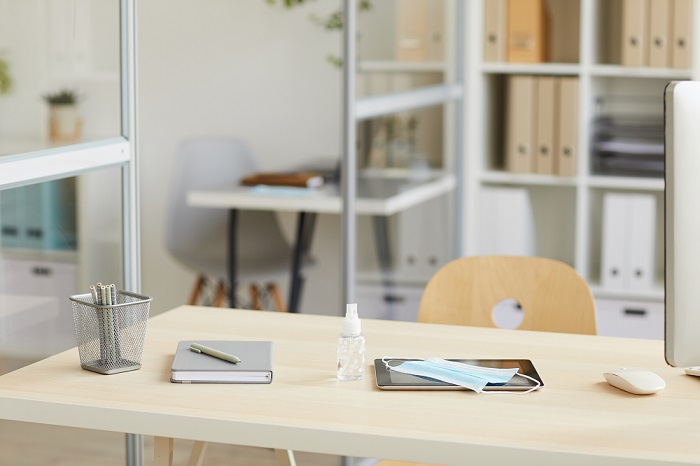The Post-Pandemic Office – what changes to expect
With a roadmap now announced to ease us out of lockdown restrictions many people are beginning to think about their return to the post-pandemic office.
Although working from home may have become a more long-term change for some, many people will now be getting ready to transition from the home office back to re-join their colleagues, face to face, in a building they left behind many months ago!
However, despite the restrictions easing, it’s likely that things won’t look or run exactly the same as they did before. Changes in guidance as a result of the pandemic will mean that businesses will have had to update their workspaces accordingly to help safeguard their building and their tenants. And although we are accustomed to the idea of social distancing and reducing the number of people in closed areas such as lifts etc, there are many more factors to be considered.
Traditionally offices have been designed to optimise tenant comfort, whereas at the stage of the pandemic the priority will be preventing contamination and protecting public health. So, tenants may have to adjust to different levels of comfort at this period in time.
When looking at the guidance developed by BESA guided by REHVA and CIBSE, we have identified some key areas of change:
Updates in HVAC systems
When looking at how to improve air quality within office buildings to help reduce possible contamination, dilution is key. Maximising the fresh air supply is highly recommended, however consideration will also need to be given to the quality of air that is being brought in. For example, offices based in the heart of cities may find that pollution levels in the air then become an issue.
In circumstances where maximising fresh air through window airing is not a viable option, guidance has now been given as to how to improve ventilation systems.
- Where possible all air handling units with recirculation must switch to 100% outdoor air.
- Extended operation times must be put into place to ensure they are fully functioning on tenant arrival.
- Avoid switching off ventilation systems but operate at reduced speeds when the building is vacated (i.e., overnight and weekends).
In terms of maintaining these systems it is likely that engineer callouts will increase as tenant capacity increases. Therefore, it is vital that engineers continue wear correct PPE and utilise remote monitoring of assets where possible.
Communication
It is likely that the tenants will play a bigger role and become more involved in decision making as they will be entitled to receive greater detailed information as to how systems within the building are run. It is important for it to be communicated to the tenants why certain systems must stay within certain setting ranges and what the benefits and reasoning for this is. This will help provide them with the knowledge, understanding and tools they need to stay safe within the environment, as well as the confidence that their workspace is following health and safety guidelines.
Therefore, it is likely that we will see a different dynamic between Facilities Managers and tenants as they work more collaboratively and with greater transparency. Clear communication will be the key to success for both parties.
Smart Tech
Although it was prevalent, pre-pandemic, plant based monitoring and real-time data has never been more important. Being able to accurately monitor air quality on an ongoing basis is invaluable for tenant health and safety and can help make informed decisions moving forward.
It has also allowed maintenance providers, and will continue to do so, to minimise engineer visits, resulting in people adopting a more condition-based approach as opposed to a planned preventative approach to help minimise physical visits to the building.
Wellbeing & Sustainability
Despite many of these changes being implemented at what is perceived as a sooner rate than many expected, some of the adjustments were likely to have been recommended in the near future as many offer benefits that increase both wellbeing and sustainability.
For example, demand control ventilation systems are now recommended to change the CO2 setpoint to lower value of 400ppm, therefore not only helping to lower contamination rates but also helping work towards achieving decarbonisation goals.
“At Hemlow we want to make sure the tenants within our client buildings are safe post COVID, while maintaining the building to an outstanding level regarding service and value. Our good working relationships with our clients are key to getting this correct for all parties involved. Our clients have been advised regarding the current recommendations and Hemlow engineers have carried out the necessary works as applicable.
The office environment is going to change compared to pre-COVID times, there will be some companies which will have personnel return full time and still require the floor area they currently occupy, others will review the way which the use their space to best suit their company culture, as we have with our new Sevenoaks branch.
Hemlow will be able to work with our clients and adapt our servicing while these changes happen to the building. One thing is for sure, the office is important for the mentoring of staff and keeps the social/family vibe of companies like Hemlow a strong part of its ethos.”
Moving forward
So, while it is unclear what the future of the workplace will look like, we know that for now these are the measures being put into place to help secure workspaces nationwide.
As we adapt to our new surroundings it is important to have the knowledge to help everyone feel confident and safe moving forward.


